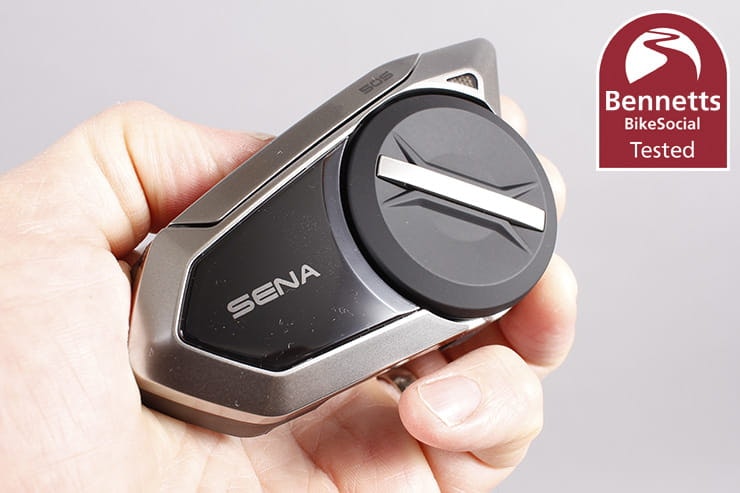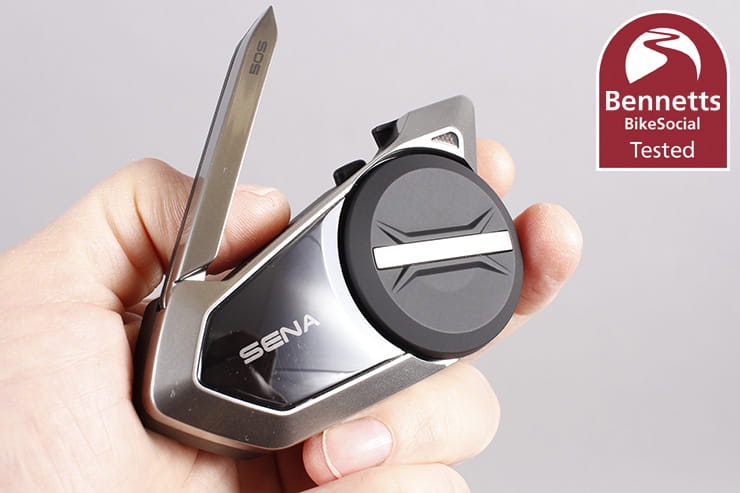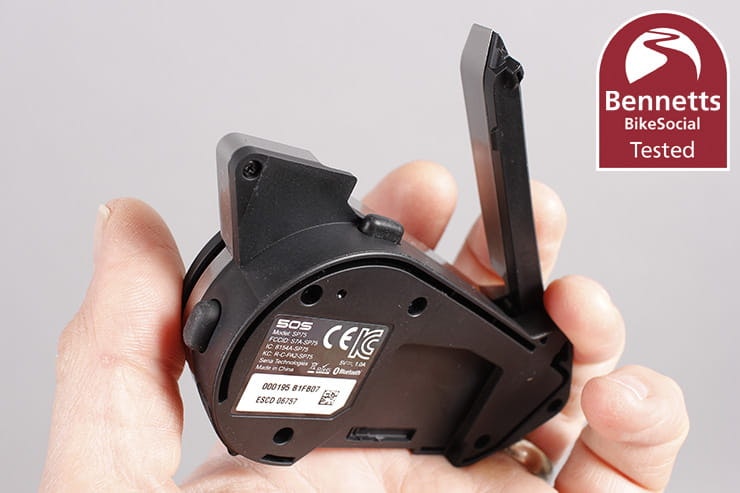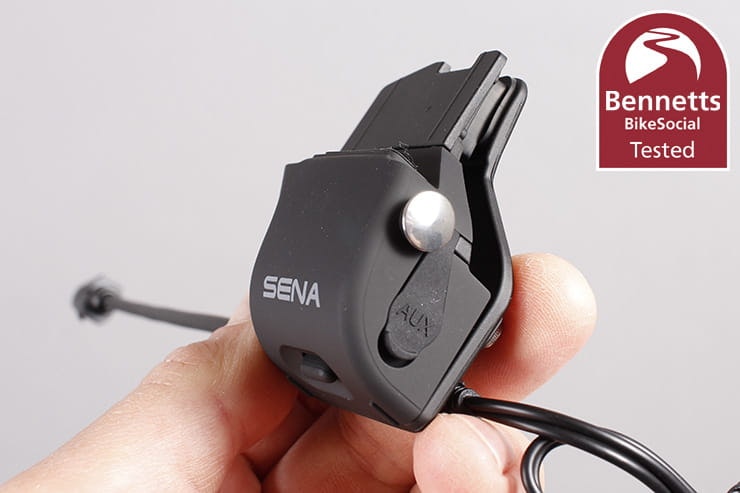Tested: Sena 50S Bluetooth motorcycle intercom review
By John Milbank
Consumer Editor of Bennetts BikeSocial
16.11.2020
Date reviewed: November 2020 | Tested by: John Milbank | Price: £309| www.sena.com
The Sena 50S is the company’s flagship motorcycle intercom. Having used it for several months on an Arai Tour-X4, riding a BMW S1000XR and a Royal Enfield Interceptor 650, I’ve been able to review its performance when making calls, listening to music, and as an intercom over Bluetooth, and using the Mesh 2.0 connection with multiple riders.
Sena also offers the 50R, which is a very similar device (with the same RRP), but three buttons instead of the three plus a jog dial and ambient button of the 50S, and a slightly lower capacity battery (a claimed drop of one hour talk time); the 50R is described as being the more rugged of the two devices, and was promoted through sponsorship of the 2020 BMW Motorrad GS Trophy, where 100 riders all used it in tough conditions.
The 50R attaches directly to the side of the helmet without the additional mounting bracket of the 50S, so loses the headphone and auxiliary port, offering an optional earbud splitter cable for those that need it, but no aux input.
This review focusses on the Sena 50S, though most of the functions are the same if you’re considering the R…
UPDATE: For the latest Cardo and Sena intercom updates, including new cross-platform compatibility, GoPro control and voice recording features, check our updates feature here.
Outstanding range
Wireless, automatic firmware updating
Simple and effective open Mesh for easy group comms
Battery life not as good as some competitors
Compatibility with other brands not the best
Water resistance (50S) is poor
Fitting
Fitting the Sena isn’t quite as simple as some of its competitors thanks to a clamp that uses two small Allen-head set-screws. A key is included, and once on it’s a very secure mount, so it’s worth the extra five minutes of fiddling.
An adhesive mount is also supplied, though you’ll need to swap some parts over from the clamp to use it.
My criticism of the mount is that it’s a little bulky, but off-setting that is the fact that there are no connectors to find space for in the lid, and it includes a button to enable ‘ambient’ mode, a 2.5mm auxiliary input for MP3 players or anything else (a long, coiled cable is supplied with a 3.5mm plug for your devices), and a 3.5mm headphone socket to use your own earbuds. Note that plugging into this disables the unit’s speakers.
I’m using the wired microphone, which sticks inside the front of a full-face helmet’s chin piece; it’s very slim – getting on for half that of the leading competitor – fixing in place with some Velcro so it’s easy to position for good clarity but without feeling uncomfortable or getting in your mouth.
For flip-front or open-face helmets, two boom mics are supplied – one that sprouts out of the mount and another that fixes inside the helmet. Swapping the mics around is a little fiddly, and you’ll need to download the full instruction manual if you can’t work out how to do it.
Once on, the mount can rub on bulky shoulder armour at times, though it’s never actually in the way. The scroll wheel is quite large, and while it’s rare, it is possible to move it during a shoulder check if you have your head tilted. But all this does is crank the volume up a touch.
You have the choice of clamping the mount on, or sticking it
Connections
The Mesh 2.0 intercom is extremely easy to use thanks to it defaulting to ‘Open’ mode. The 50S turns on in Bluetooth by default, but pressing the button on the top switches it to Mesh. Cleverly, the button is tucked behind the pop-up antenna, meaning you’re less likely to forget to lift this, which does make a difference to the signal strength.
Open mode is described as being capable of handling a ‘virtually limitless’ number of riders, and while it does mean that anyone with the same device could listen in and participate with your conversations, it’s not really likely to cause any headaches. In fact, imagine a world where someone riding in the other direction can wave and say hi; pretty neat.
In practice, the open Mesh setting will suit almost everyone, and if you are getting any interference, you can switch from the default channel 1 to any of the eight others. You can also set up a private group of up to 24 riders if you prefer, which will always stay paired and be accessible by holding the Mesh button for three seconds.
Mesh is a huge improvement over Bluetooth comms as when riding in groups with the old tech, if any rider loses connection the group falls apart, which means they have to stop to pair up again.
Mesh makes things a lot simpler as you can set it up once then forget about it, and unlike Bluetooth, it doesn’t matter if the riders change their order on the road, or if one leaves the pack.
You can use the Sena 50S as a Bluetooth intercom, though in this mode you’re limited to a maximum of four riders.
A 50S user in Mesh can include a Bluetooth user in a Mesh conversation – I tested this using a pair of 50Ss in Mesh mode, with a Sena 10C in Bluetooth and all three were able to join in the conversation
If you ride in a group of more than two and want to be able to communicate, it really is worth buying a Mesh system, but do bear in mind that it’s not universally compatible – you’re all going to have to buy the same brand.
The mounting bracket includes headphone and auxiliary ports
Mesh intercoms typically don’t work across different brands, but it’s just been announced that the new Mesh devices from Sena and Interphone will be compatible.
Sena also has a universal Bluetooth intercom pairing mode, but I’ve struggled with it – pairing it to a Cardo meant setting the competitor’s device as a phone. To pair a Sena 50S to a Cardo Packtalk you need to carry out the following steps, though it will be a similar procedure for other Sena and Cardo devices:
Put the Cardo in phone pairing mode by pressing and holding the phone button for five seconds, until the LED flashes red. If you want to use the ‘second mobile phone option’ tap the phone button twice when the LED is flashing red.
Access ‘universal pairing mode’ on the Sena by holding the jog dial down until you get to the configuration menu, then turn the dial anti-clockwise twice until you hear ‘universal pairing’. Finally, press the phone button on the rear of the Sena to activate pairing and the two should link up.
It seems to be the same process when connecting the Sena to an old Interphone F5MC, but interestingly, the Cardo paired without issue to the same device.
On the other hand, there are a lot of people out there with Sena intercoms, not least because the company also makes the units for Shoei and Schuberth lids, so there’s a good chance it might be the brand your mates have, and the upcoming compatibility with new Interphone devices should not be underestimated.
The auxiliary connection might appeal to some users, but I expect any headset to connect all my devices via Bluetooth, so smooth connections here are really important to me, and with the GPS connected through GPS pairing mode, instructions are fed direct to the intercom.
With my Samsung Galaxy S10 paired to the Sena, I’m able to listen to music or the FM radio, and the TomTom interrupts to give directions, the entire message usually being clearly spoken.
While the two Bluetooth intercoms paired automatically, I did have an issue with the TomTom – once that had made an announcement, the second intercom (the one not paired to my other devices) couldn’t initiate a conversation, even when the TomTom wasn’t speaking any more. The ‘main’ unit (paired to the sat-nav) was still able to link the two up, so if you don’t disconnect (remember that you’ll only hear the other person when they speak), you won’t be aware of this glitch.
I did have some issues with the TomTom during my test of the Cardo Packtalk Bold as well, but found that was sorted by pairing the GPS as a ‘second mobile phone’; trying that on the Sena didn’t work, so for some reason the two just don’t play nicely.
The speakers fit fine in my Arai TourX-4
Trying to cover every eventuality, I also found that, with two 50Ss connected via Bluetooth, music played fine though my headset (and could be shared with the other user), the intercom speech overlaying if you want or interrupting it altogether. The TomTom had no problems cutting into the conversation, but after the message was complete, if music was playing it suddenly went incredibly loud, overdriving the speakers significantly. This is in some way related to having a 50S connected as a Bluetooth intercom, as it didn’t happen with a Sena 10C connected, or when the 50Ss were connected by Mesh. Turning off ‘Audio Multitasking Volume Management’ in the app stops it happening, but if you do experience this, turning the music off then on again will reset it to the normal volume.
With two Senas connected via Mesh the TomTom seemed to work fine, but I did notice that if either user presses the scroll wheel in, the Mesh connection is disabled as the unit connects via Bluetooth. Press the Mesh button and it reconnects, then disconnects itself, so you need to press the scroll wheel again to turn the Bluetooth connection off.
While Google Maps and Calimoto on the phone will interrupt music that’s being streamed from the same device, the intercom will overpower it – so if someone speaks as the directions come through, you won’t hear them. Also, when the radio is on, the phone’s directions don’t interrupt it, so you can’t hear them (I also tried pairing the phone as a GPS but it wouldn’t work). An audio priorities option like that found on the Cardo could help here.
Note that when using Mesh between two people (for instance as a rider and pillion) you can press the button to leave the conversation, but unlike with Bluetooth, the other person won’t be able to initiate a conversation again until you reconnect. Reconnecting also gives the voice instructions “Mesh intercom on, open Mesh, channel one”, so this is a full disconnect, rather than simply muting the conversation.
Ultimately, the connections on the Sena 50S are generally fine, but I did dig out some glitches and the odd slightly confusing function.
Control
The Sena’s large jog wheel makes it easy to change volume (though unintuitively, you turn it backwards (clockwise) to increase the level. It’s not hugely tactile though – a click to the steps would make it easier to feel it moving with gloves on. The buttons are fairly easy to find, but all of these controls become fairly irrelevant thanks to voice recognition, where the number of commands accessible is impressive…
Voice control is very useful, but unfortunately I don’t have total success with the Sena system. My colleagues have often referred to me as a lispy, conical-headed t**t, so it’s perhaps no surprise that some of my instructions can trip it up, but I do have significantly better results with the Cardo Packtalk.
I have a suspicion that, in trying to add so many commands (more than offered by Cardo’s kit), the Sena is looking for too much detail in the speech, which can get lost in a noisy environment from a fat-tongued Fenlander like me.
I have the most trouble with ‘Hey Sena, stop music’, with perhaps a 30% success rate. If I very clearly enunciate the plosive in ‘stop’, it seems to work a bit better, but the device also doesn’t seem to like one command directly following another, so you need to pause a few seconds, then try again, which can be frustrating when you need to shut the music off to speak to someone.
Of course, you can hold the jog wheel for a second or so to turn off the tunes, and others may have more success; YouTube’s auto-subtitles are a joke on my videos, whereas clear-speaking Michael Mann’s are a lot better.
Ultimately though, this could do with some fine-tuning via firmware, though it’s not helped by the fact that some commands seem a little overly-complex; “Hey Sena, FM radio on” could surely have been “Hey Sena, FM on”, which would also be more logical when it’s what the voice says back to you.
The app is a handy way to control the Sena 50S from your handlebars, as long as you have it mounted vertically
Another way to control the Sena 50S is via the dedicated app, which allows you to access all ten of the FM radio presets, three phone speed dials, intercom settings and music controls. This works well as long as you have good touch-screen compatible bike gloves, and you can also adjust all of the device’s settings via the app.
It’s a neat touch to also find the quick-start guide and full user manuals accessible from the app if you ever get stuck, though I do wish the app would rotate so you could use it in landscape mode.
Finally, you can use ‘OK Google’ or ‘Hey Siri’ to access your phone’s personal assistant, but as with the Cardo this doesn’t work at speed due to the phone not having the noise-cancelling capabilities of the headset.
Volume and clarity
The overall volume of the Sena is very good, with decent clarity from the new ‘HD’ speakers. These 40mm drivers give decent enough base and sparkle, but they do start to distort a small amount at full volume.
Comparing them in a controlled test environment with the Cardo Packtalk Black, which comes with premium (priced) 45mm speakers, the Sena 50S doesn’t have the same high quality, lacking a little in the deep tones. Turn on the Sena’s bass boost and it improves, but it’s not quite there.
However, on the road in a 70mph wind with ear plugs in there’s a lot less difference. The Cardo’s 45mm speakers do offer more than bragging rights, and don’t distort, but you’ll be hard pressed to tell unless you’re running them back-to-back.
Ambient mode is activated with the button on the bottom of the mount
The Sena offers an ‘ambient’ mode thanks to the helmet mount – tap the button twice and it acts almost like a hearing aid, supposedly amplifying the sounds around you. This should be useful in petrol stations or when asking directions, but it simply doesn’t work, merely amplifying the sound of your fingers brushing on the intercom casing. If you’ve got earplugs in, people will just need to speak a louder.
The wired microphone is very slim
Sena 50S range
Compared to its main rival, the range of the Sena 50S is excellent. Sena claims 2km (1.2 miles) in open terrain, and my standard test is on a straight, flat road with no traffic. My wife stands in one location, facing down the road, while I ride away, monitoring the connection as she speaks constantly.
This is the best I’ve seen, and while there will always be some variables, this test was carried out within minutes of the Cardo, so atmospherics didn’t play in Sena’s favour. In fact, the road runs out at 1,330m, and as I turned the bike around, I was reconnected to Helen, even at this range.
The ranges achieved on my straight test road were absolutely outstanding
Mesh allows for greater total range in a group as the signal effectively bounces off of each unit. Sena claims up to 8km (5 miles), but it takes a minimum of six riders to achieve that, and while they’ll all be able to talk to eachother, regardless of their position in the pack, there will be a maximum range between each in order to keep everyone connected.
While I was unable to test with a group of that size, I had one ‘rider’ stand in a set location with a unit attached to ear defenders, then rode off until the limit of the connection. There, the second ‘rider’ stood and turned their unit on. I then rode off as ‘rider 3’ to check that we were all able to continue talking.
The test was carried out on the edge of a quiet village, with no traffic between the units.
Here you can see where the ‘riders’ were for the Mesh test. Rider 1 is effectively the tail rider of this test, rider 2 marks the limit of that connection, then rider 3 shows how the Mesh system increases range while keeping everyone in conversation
The distance from rider 1 to rider 2 wasn’t as good as the clear road test, but this is a real-world scenario and it’s important to remember that this acts as a comparison to other Mesh-enabled devices that we test (like the Cardo Packtalk Bold / Black). The road opened up out of the village shortly after where rider 2 stood, so the range from them to rider 3 was greater, making for a total distance of 960m between riders 1 and 3. As rider 3 lost connection, riders 1 and 2 were still able to continue talking.
Once the maximum distance was recorded, I, as rider 3, then turned around and rode back past each of the other testers to ensure the Mesh would stay connected as the order changed around. Both testers turned 180° as I rode past, so we were always facing the same direction.
This is the second part of the Mesh test – riders 1 and 2 stayed where they were, but rider 3 (me) turned around and rode past them until the connection was again lost. Everyone faced the same direction, and here rider 2 was able to talk to rider 1 still, and until the limit of the connection, rider 3 was part of the conversation.
Going in the opposite direction, the road takes a turn past a tree and it’s into the village, creating more opportunity for the signal to be blocked. No traffic was between the devices during measurement.
The beauty of mesh is that it automatically reconnects, and it will bounce off the riders no matter what order they’re in. So in practice, a group of riders should be able to maintain good, clear communication for the majority of their trip, and the Sena is certainly offering the best range of anything I’ve used to date.
Radio
Intercom radios generally leave a bit to be desired, and I’ve yet to find one that gives anything like the stability of what you’ll find in your car. But the Sena 50S isn’t bad, holding a connection to Radio 4 over a 25 mile ride, though there was some interference and breaking up at times.
There are 10 station preset slots that you can access by saying ‘Hey Sena, next’ or ‘previous’, by pressing the jog dial then rotating it, or through the app.
RDS is included, which allows the radio to auto-retune, though sadly – like others – it doesn’t say the name of the radio station, only the frequency.
The charging port is USB-C
Sena 50S battery life
My test of any intercom’s battery life is carried out by playing music streamed from my phone at full volume until it stops – this gives a consistent and repeatable comparison between devices.
The Sena is okay, but not the best, coming in at 9 hours and 40 minutes. Sena claims 14 hours of talk-time through Bluetooth and 9 hours using Mesh, so while a group chat will reduce the time you can waffle on, it should be enough for most rides. It’s possible that Sena’s exceptional range is having an impact on battery life, so you’ll need to decide what’s most important to you.
The 50S takes only an hour to charge, and just 20 minutes will give you a claimed 6 hours of talk-time in Bluetooth and 3.5 hours in Mesh, so topping up at lunch should mean you have no difficulties at all.
It’s great to find a USB-C charging port on the 50S, which should mean carrying fewer cables, and it’s worth noting that the Sena can be used while it’s being charged.
Sena 50S waterproofing
In what’s been a design oversight for several generations of devices, the Sena 50S has no Ingress Protection (IP) rating. It’s claimed ‘water resistant’, and in showers it tends to be fine, but in heavy rain at speed, water can stop it working. I have had it shut itself down once, though it booted straight back up without issue.
It’s difficult to see where the water gets in to cause a problem, but I suspect it’s the connections between the bracket and the unit, which uses a thin rubbery seal. If Sena is serious about the European (and particularly UK) markets, it needs to have a think about the design of its products.
While I haven’t used the Sena 50R, the lack of mounting bracket and simpler design (plus Sena’s claims of it being the ‘rugged’ option) make me think this would be better in the rain. Though there’s still no IP rating…
The supplied charging cable can be used for automatic updating, but you can charge with a normal USB-C cable
Ease of updating
Updating the Sena is much simpler than its competitors, which need plugging into a computer – the supplied charging cable (Duo-packs do get two charge cables) has a WiFi dongle built in; once you’ve set this up via your smartphone, it will automatically connect to your WiFi network and update your device whenever necessary, once it’s plugged in.
It’s important that the cable is plugged into a USB charger (one isn’t supplied) and given a few seconds to connect to your network before you plug the intercom in as the update check is run immediately. Other than that, it couldn’t be simpler, and as I’ve had three updates go through in two months of testing, the simplicity and guarantee that it’ll always have the latest firmware is appreciated.
Sena 50S intercom review: Verdict
The 50S has a lot of great features, and the range is absolutely outstanding – it’s much better than its main competitor. I’m also really impressed with the simple updating, and while it might not have the very best definition when it comes to music, at 70mph it’s a lot harder to tell any huge difference.
But the vulnerability to water ingress is a real issue for UK buyers, and after all these years there seems little excuse. The not-quite-perfect voice control and the grumbles with the connections add to the disappointments with the Sena. Fortunately, the Sena 50R is basically the same inside, but it IS waterproof. You can read our review of the Sena 50R here.
What your mates own will make a big difference to your buying choice, and the fact that Sena and Interphone have joined forces to offer new devices with compatible Mesh technology from 2021 is a very big deal.
UPDATE: For the latest Cardo and Sena intercom updates, including new cross-platform compatibility, GoPro control and voice recording features, check our updates feature here.



